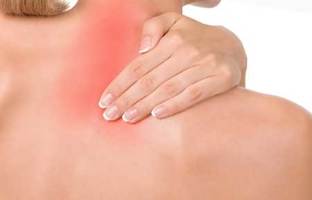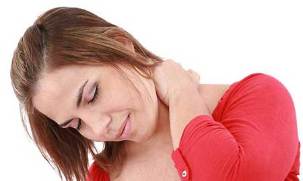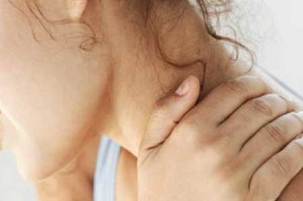In the world there are a few diseases that belong to a person just because he is a man. For example, the defeat of the vessels and deposits on the walls of cholesterol occurs in the animal world. The symptoms of the disease degenerative disc neck may be confused with symptoms of other diseases. The Increase in blood pressure is own to all warm-blooded animals. A poor diet can lead to burnout and a deficit of protein and vitamins and chicken, and the elephant, and clam, and fighter of free-style. But osteochondrosis of the spine refers to the disease, which can be proud of the man alone: even his closest relatives, primates, the disease is almost absent. We will understand in the manifestation of symptoms and methods of treatment of degenerative disc disease of the cervical spine.

Osteochondrosis cervical, what is it?
Osteochondrosis of the cervical spine is a disease of the bone and the cartilage which relate to the dystrophic — degenerative. It is based on the dystrophy (violation of the power supply to the cartilage), then its destruction or degeneration. In fact, low back pain primary suffering the cartilage of the intervertebral discs, iup "ball of snow" is completed by the reaction of the bone tissue (osteophytes), the advent of protrusions and hernias, root symptomatology, the onset of instability in the cervical region, as well as the pronouncement of headaches and chronic muscle spasm of the deep muscles of the neck with a disorder of regional blood circulation. The reason for the appearance of degenerative disc disease of the intervertebral disc in the cervical or cervico – thoracic region, a single: it is historically constituted, the vertical position of the man. Neither the cats, nor in cows or hippos is not such a constant, the axial load of the vertical located on the back, the spine is in a state of relaxation, the "collapse" of the state, and the intervertebral disks will feel comfortable. The man in the development of cervical osteoarthritis predisposing factors the following:
- Frequent to find in the vertical position;
- Injuries and sudden movements, head shots, for example, on the ceilings low;
- The carrying loads on the shoulders, in some countries, on the head;
- The lack of active movement. It leads to muscle weakness, a corset, which is essential in the cervical region of the spine.
Also, other factors include the wearing of heavy winter collars and cuffs of fur hats in order to "serve mode", the reduction of the consumption of liquid, due to a primary dehydration of the cartilage. This increases the fragility of the discs and is called "the draw" (contraction of the thickness), reducing elastic buffer properties. In his youth, osteochondrosis may result in a violation of posture in the execution of written work, and working at a computer. Congenital alteration of the spine, e.g., scoliosis deformity in the thoracic region. It is to remember that the above is the department of the vertebral column, more dynamic, which can have a detrimental effect, by analogy with the "whiplash" trauma. Therefore, the stall or the violation of compensatory mechanisms, protecting our skull excessive and concussions, also leads to osteochondrosis of the cervical spine. Here are these reasons:

- Flat feet, such as longitudinal and transverse. The arch of the foot, devoid of the damping, is unable to protect the intervertebral discs of the cervical spine of the commotion and destruction.
- Underlying osteochondrosis of the lumbar spine. If the elasticity of the back is broken, not worth waiting for a good protection of the cervical spine.
The symptoms of degenerative disc disease of the cervical spine
The signs of degenerative disc disease of the cervical spine are very different, but we can combine local and remote of the event. The symptoms of cervical arthritis are:
- Printer and pains, muscle soreness, low-intensity, aggravated after a long siege, for example, if you work in an office and the computer;
- The popping sound when the movement of the neck. The more strongly it is felt at the execution of the exercise in the morning, in this case, if ears with your fingers. Then the conductivity of the sound exceeds the air, and turning the neck audible crack well. This symptom reflects the appearance of osteophytes, which disturb the matching (precision support) in the cartilage and the vertebral column;
- Of the neck pain, like when driving (mostly abrupt). This pain, called Servicio, by analogy with the "heat" could in the back is lumbago. These pains are already at root manifestations of the degenerative disease of the disc. They occur when the sudden jolt of the nerves are on, which occurs when laughing, coughing, sneezing, tender. This pain like neuralgia, and looks like a stroke of electric current, its strength, and surprise. The more often it occurs in the thoracic region of the spine;
The ends of the star are the following:
- Headaches low back pain. Ask discretely, like a "helmet" or "helmet", often symmetrical. The intensity of their low, they may be associated with the movement, but not necessarily. Often, they "pass" on the head, at the nape of the neck, and accompany the sedentary life.
- Tag sensitivity disorders. Often occur at night – waking, the person feels numb fingers of the hand. Most often it is the ear, and half of the anonymous fingers on the side of the little finger. To restore the sensitivity, the need to move the hands, nape of the neck and change position.
This occurs because of the damage to the roots of the brachial plexus in the places of output of nerves are. It is important that the heels are for the most spasserovannye the muscles of the neck, which prilezhat to pozvonkam. Osteochondrosis cervical, the symptoms of which, we have seen, can be complicated by instability of the cervical spine. The height of all intervertebral discs in the cervical region will also be reduced, and the neck becomes "pathological mobility", or the inclination at the onset of pain and a variety of deformation during the driving. When this condition occurs the frequent occurrence of infringement of the nerve roots are and increases the risk of protrusions and hernias.

The role of the muscle spasm
There are secondary muscle spasm, which is called myofascial — toned tail. This state may be encountered in the various departments of the spine, anywhere where there are transversely striped muscles. The result of the reduction of the height of the intervertebral disc, and the spread of the limit value of osteophytes, muscles, "fired," and blood circulation worsen. In consequence to reduce venous reflux. This situation leads to a swelling of the muscles and their spasm of the chronic disease, which is manifested by pain and discomfort in the neck and back.
The diagnosis of osteochondrosis cervical
In typical cases of osteochondrosis of the cervical spine makes symptoms described above. This is why the diagnostic phase has been and remains to identify the patient's complaints, the existence of a vein muscle spasm using a simple palpation of the muscles along the spine. To confirm the diagnosis of degenerative disease of the disk, you can using the x-ray examination:
- "X-ray" of the cervical spine, yes, even with functional tests on the flexion – extension shows no cartilage, so that their tissue-ignores x-rays.
Despite this, on the location of the vertebrae, you can draw general conclusions on the height of the intervertebral discs, straightening of the physiological flexion of the neck lordosis, and on the existence of the limit value of outgrowths on the vertebrae during extended use of the irritation of their surfaces fragile and dehydrated intervertebral discs. Functional Tests help to confirm the diagnosis of instability in the cervical region of the spine;
- Magnetic resonance imaging and x-ray computed tomography of shows for the refinement of the internal structure of the cartilage and the education of protrusions and hernias.
So exactly presents the diagnosis of the complications of the disease, and the result of the ct scan is an indication for surgical intervention of the hernia in the neurosurgery department.
The treatment of cervical osteoarthritis, drugs
The treatment of degenerative disc disease of the cervical spine has always been complex: first of all removed acute pain with medication, iup, when the neck of low back pain (pain decreases) regress, joined by sessions of physiotherapy and massage, methodology, and after the relief of this exacerbation begins the phase of secondary prevention, which has the task of bringing to the avoidance of exacerbations repeated. Sometimes, the patient is system to a thermal cure. The main groups of drugs for the relief of acute pain are:
- Nonsteroidal Anti-inflammatory drugs. Cropped inflammatory component;
- The muscle relaxants of central action . Reduce the tone and spasm of the muscles, reduce pain, stiffness in the muscles;
- The vitamins of the group contribute to the improvement of the food chain in the nervous system;
- Drugs to improve the microcirculation of capillary blood, — to improve the exodus and normalize muscle function.
These funds are allocated to the interior, or by intramuscular injection for more efficiency. The aim is to raise the syndrome of acute pain. Then after 2-3 days go on taking the tablets, actively used for ointments or gels that rubbed in the neck and back. The second phase of the join the physiotherapy is electrophoresis with vitamins and hydrocortisone, massage, deep stretching, and a shower with powerful Jets, iglorefleksoterapevta of the methodology. It is sometimes prescribed drugs chondroprotectors, but during the indoor reception of their effectiveness until now, has not been proven. Single intra-articular injection of a substitute for the synovial fluid helps reduce cracking, improve the circulation and eliminate the pain. But osteochondrosis this technique, the wastewater on the major joints, almost does not apply. A surgical treatment is performed during the compression expressed their parish priest or hernia sensory or motor of the binding. Indication for surgery refractory expressed pain during the course of the month, intractable to treatment, or to the evolution of the weakness in the muscles of the hand, extension of the area of the reduction of the sensitivity, and the confirmation of the diagnosis of the protrusion and herniation using MRI or CT.
Gymnastics for osteochondrosis cervical
The gymnastics in osteochondrosis of the cervical spine of the vertebral column is nothing other than the management of the compliance of motor activity and a healthy lifestyle: in fact, the osteochondrosis is found among all people without exception, since childhood, and even something considered as "normal". Because there is no one who, in particular, the adult would not have had signs of degenerative disc disease, then the task of the exercise is to leave only the objectives and the radiological signs of the disease, and eliminate all the complaints. It is known that, even older, and an old man may not present a complaint to his neck and back, but only if given sufficient time to prevention.
The prevention of cervical osteoarthritis
Perhaps, the example of the degenerative disease of the disk, you can remove the general principles of prevention, which are shown to all the world, and as a result, we get the rules of life in good health. Here they are:

- The freedom of movement, without too much weight, exercises without load, only to the mass of the body;
- Drink plenty of pure water, because with age comes the dehydration of the cartilage;
- The conservation or the normalization of the mass of the body;
- The lesson of these types of loads, which reduce the load on the back (swimming);
- The refusal of bad habits;
- The alternation of mental of the physical. Through each half – hour of mental, it is recommended to change the type of physical activity of work;
- Avoid hypothermia in the neck, back, and kidneys, especially in the spring and fall.
Only if the respect of these simple recommendations osteochondrosis of the cervical spine, the symptoms and the treatments that we have thoroughly taken apart, not to disturb you for years.
































